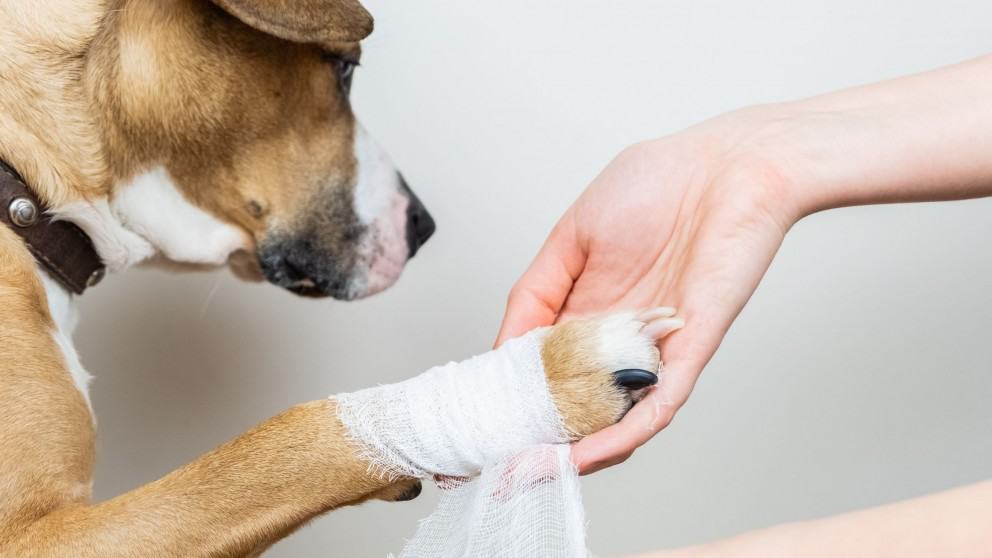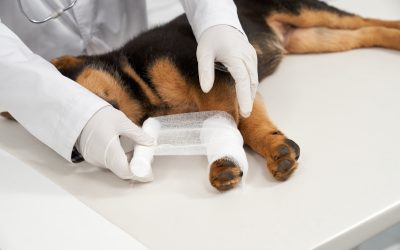Why is My Dog Limping? 6 Possible Causes

Did your dog just come inside from playing in the yard and is now limping? Or maybe, your dog is limping after a longer-than-usual nap and doesn’t want to put weight on a particular leg. No matter what the cause, wondering, “Why is my dog limping” can be a concerning thought.
There are so many reasons why your dog may suddenly have started limping on one of its legs. Unlike humans, dogs cannot tell us where it hurts or what happened. A dog limping is often the first visual sign that it might be in pain or something might be wrong, so it’s important to be vigilant of this dog injury, especially if the limping lasts more than a few hours.
This article will explain what causes dogs to limp, possible reasons why your dog won’t stop limping, and, most importantly, what you can do to help your dog quickly recover.
Why Is my Dog Limping?
There are many reasons why your dog may be limping. As dog owners, it is up to us to identify odd behaviors so we can communicate that information with the veterinarians. Sometimes, like in the case of an injury, it can be obvious why your dog is suddenly limping on its back leg. In other cases, the reason why your dog won’t put weight on their back leg may be a more gradual onset.
If your dog’s leg limps, these are some of the most common reasons and symptoms dog owners should look out for.
1. Broken Leg
A broken leg is probably one of the most obvious and often severe causes of limping in dogs. Your dog may have been hit by a car or caught its leg in something in the backyard, causing its leg to fracture or break.
In many cases, you will be able to see where the leg has broken, especially if the bone has penetrated through the skin. While this kind of injury is often accidental, it’s important always to monitor your dog’s playtime to avoid this kind of traumatic accident or, at the very least, be able to describe what exactly happened to your veterinarian.
Common signs that are seen when a dog has broken its leg are:
- Swelling on and around the leg
- Bruising
- Limping
- Crying in pain
If you think that your dog has broken its leg, it is best to take them to your vet or an emergency vet as soon as possible. Your veterinarian will thoroughly examine your dog and take x-rays of your dog’s leg to confirm that it is broken. In some cases, your dog may have to have surgery to fix the break.
This will all depend on where your dog’s leg is broken and the severity of the injury or trauma. Your dog may need to wear a cast for a few weeks until the bones heal. Following your veterinarian’s directions and keeping the cast clean and dry will help prevent further issues.
If you have any questions during recovery, it’s best to call your veterinarian for advice. They can help provide guidance and even recommendations for further physical therapy or surgery for your dog if needed.
2. Torn ACL

A more common dog injury is a torn ACL. A torn ACL is commonly seen in medium to large-breed dogs due to their energy levels and the impact on their muscles. The ACL is a ligament in the knee that helps stabilize the leg when walking (just like us humans). A classic sign of a torn ACL is sudden limping shortly after exercise.
Most dogs diagnosed with an ACL tear are typically very active. So if you’re wondering why your dog is limping after playing fetch or running outside, a torn ACL may be the cause. These tears will happen while they are active, and symptoms like limping will be seen immediately.
Often, dogs with a torn ACL won’t put weight on the affected leg and may yelp or cry in pain the moment they experience the tear or the immediate aftermath.
If your dog suddenly limps or does not put any weight on its leg, it is best to see your vet. Often, surgery is the only way to fix an ACL tear and this type of limping. Your veterinarian can suggest options to help decrease pain or discomfort until your dog’s surgery.
3. Something Stuck in Their Paw
Another reason why your dog may be limping is if they have something stuck in their paw. Dog paws are resilient to an extent, but if your dog won’t stop limping, keeps licking one paw, or won’t put weight on one leg, they may have something stuck in his or her paw.
Common items found stuck in a dog’s paws are rocks, thorns, or sticks. You can closely examine your dog’s paw and see if there is something stuck between their toes. If you cannot find anything, take your dog to the veterinarian so they can help look for hidden thorns.
If your dog is in pain, they may hesitate to give you their paw. So, it’s important to seek veterinary care if this is the case since your veterinarian is equipped with the right tools and compassion to handle your pet with care.
4. Broken Toenail
A broken toenail can also cause limping in dogs. For example, a dog will accidentally get a toenail caught in a blanket or rug, causing a break when they go to move. Or, they may scrape and break it on hard surfaces like concrete or rock. When your dog breaks a nail, it’s not just inconvenient, like when it happens to us humans, but it can be downright painful.
Many times, this break exposes the quick, soft pink tissue in the center of the nail, causing the toe to bleed. Once the bleeding stops, your dog may limp for a few days because the toe is still tender and painful. If your dog only partially broke their toenail, it may need to see a vet. The vet will trim the rest of the nail and apply a bandage, if necessary, to minimize further pain or bleeding.
In this case, the cause of your dog limping may seem like a minor problem, but it can be painful for your pet due to its anatomy. It’s also important to ensure their broken toenail is bandaged in some cases so they can heal properly and not be exposed to dirt and bacteria.
5. Hip Dysplasia
Hip dysplasia is commonly seen in large breed dogs such as Labrador Retrievers and German Shepherds. Hip dysplasia happens when a dog’s hip joints do not form correctly, causing the ball of the femur to not fit properly in the socket. The rubbing or grinding movement of the ball in the socket causes increased bony growth leading to arthritis formation. If your dog develops arthritis, this can lead to a gradual onset of limping.
Common signs of hip dysplasia are:
- Pain and difficulty when trying to sit or stand
- Limping
- Painful when touching hips
- Abnormal gait
See your veterinarian if you notice any of these symptoms, and your dog won’t stop limping. They can take x-rays of your dog’s hips to see if he or she does, in fact, have hip Dysplasia and the severity of the condition.
They also understand the complexities of hip dysplasia and how it affects different breeds. This knowledge, along with the x-rays, and a comprehensive understanding of your pet’s unique medical history, will allow them to make the correct diagnosis and implement a plan of care.
Many times, vets will prescribe pain medication to help decrease the inflammation in the hip joints giving your pet relief. Dog owners can help decrease the chance of hip dysplasia by asking breeders about the parent’s medical background and picking a puppy from a litter with parents without hip dysplasia since this dog injury has a genetic component.
6. Arthritis

As your dog ages, it may start to develop arthritis. This is a buildup of extra bone in and around the joints that causes inflammation. The joints most commonly affected are the hips, knees, and elbows. This joint disease can be uncomfortable. However, there are some steps you can take to help keep your dog healthy as they age.
If your dog is limping on one of its legs, like their hind leg, you can carefully examine and move the different joints in that leg. If they are developing arthritis, you will be able to feel the crepitus (grinding, crackling, and popping) as you move the joint.
While this is often a natural part of the aging process and may feel inevitable, Petside says there are many steps you can take to help decrease the pain associated with arthritis. Medicines and other therapies such as Non-steroid anti-inflammatory Drugs (NSAIDs), Glucosamine, or other joint supplements can help keep your from limping as much and make them feel more comfortable.
What if Your Dog Won’t Put Weight on Their Leg
Sometimes, seeing that your dog’s leg is limping isn’t obvious. Rather than walking, your pup may refuse to put any weight on their leg at all. Just remember that if your dog doesn’t put weight on their back leg suddenly, it could be a sign of pain for any of the above reasons.
Some experts recommend a quick at-home exercise to see if your dog can bear any weight on their hind leg or if they refuse. The latter can be a sign of a fracture, bone tumor, or more severe wound. However, in either case, you should always see your vet when your dog stops bearing weight on their legs, especially if the behavior persists for more than a day or two.
When to seek Veterinary Care for my Limping dog?
If your dog has just started limping and you cannot find an obvious source, waiting a few days is okay. They may just be experiencing some discomfort that will be gone in a few days (like how we get muscle cramps).
You should take your dog to the vet as soon as possible if you notice obvious trauma to their legs, such as bruising, bleeding, or not being able to walk at all. Many causes for limping need to be addressed in the first 24 hours for a successful outcome.
it is also best to see your veterinarian if your dog’s limping worsens or won’t stop after a few days. Do not give any over-the-counter human pain medications, as many of them are very toxic to dogs, even in small dosages.
Possible Treatment of Limping in Dogs
Regardless of the underlying cause, it’s essential to have your dog examined by a veterinarian to determine the best course of treatment. Depending on the diagnosis, the following options may be recommended:
- Rest and Medication: For minor injuries or sprains, your veterinarian may prescribe anti-inflammatory medications and recommend rest and limited activity to allow the injury to heal.
- Physical Therapy: Physical therapy can be highly beneficial for more severe or chronic conditions, such as arthritis or developmental disorders. It may include exercises, massage, and other techniques to improve mobility and reduce pain.
- Surgery: In some cases, surgical intervention may be necessary to address the root cause of the limp, such as repairing a fracture or correcting a developmental disorder.
- Assistive Devices: Depending on the severity of the condition, your veterinarian may recommend the use of assistive devices, such as braces, splints, or mobility aids, to support your dog’s limb and alleviate pain.
- Dietary Changes: Adjusting your dog’s diet to include supplements or foods that support joint health can also be helpful in managing limping and other mobility issues.
Prevention of Limping in Dogs
While some causes of limping may be unavoidable, there are steps you can take to help prevent or minimize the risk of your dog developing a limp:
- Regular Exercise: Maintaining a healthy exercise routine can help keep your dog’s muscles, joints, and bones strong and resilient.
- Proper Nutrition: Feeding your dog a balanced, high-quality diet that supports joint health can help prevent issues like arthritis and developmental disorders.
- Weight Management: Ensuring your dog maintains a healthy weight can reduce the stress and strain on their joints, lowering the risk of mobility problems.
- Grooming and Nail Maintenance: Regularly grooming your dog and trimming their nails can help prevent injuries and discomfort that can lead to limping.
- Veterinary Checkups: Scheduling routine veterinary checkups can help identify any underlying conditions or issues early on, allowing for prompt treatment and prevention of more serious problems.
Final Thoughts on What Causes Dog Limping
If your dog is limping, there are many possibilities for its cause. Sometimes, the reasons for your dog’s limping may be extremely obvious, while others are not.
Only your veterinarian or an expert at an animal hospital can examine your dog and take X-rays to help determine why your dog is limping for certain. Depending on the cause (age, broken bones, or dislocated joints), your veterinarian will then prescribe pain medication, joint supplements, muscle relaxers, or physical therapy to help your dog return to their normal happy, and healthy life.
Odie Pet Insurance can help take the pressure off if you have to see the vet because your dog is suddenly limping. Get all your questions answered about how it works and what is covered.
How often should you be taking your pet to the vet? Read more here.



